- You are here:
- Home »
- Drills & Exercises
Category Archives for Drills & Exercises
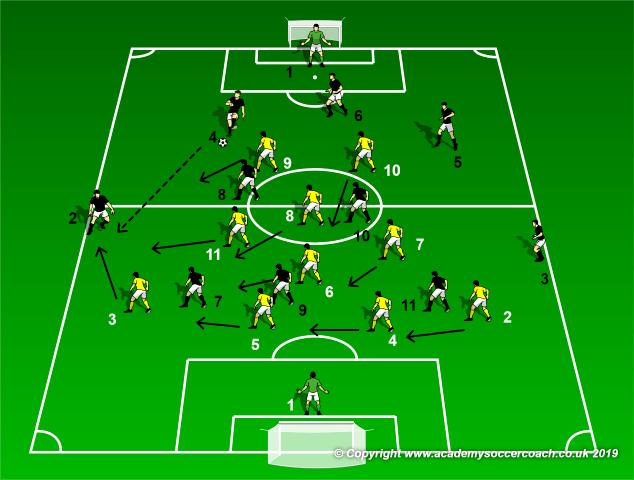
The Dortmund SSG
By Matthew Carroll –
Description: The Dortmund is designed to improve the attacking players vision and response to passes and recreate patterns created in tight spaces to create shots. It should be an activation phase drill to prepare the striker to receive killer passes in the final third.
Setup:
Players (6) are placed in a rondo formation with one player in the middle. 20 feet away from the rondo at either end are two goals with/without goalies. Each player, other than the one in the middle and the goalies, has a ball.
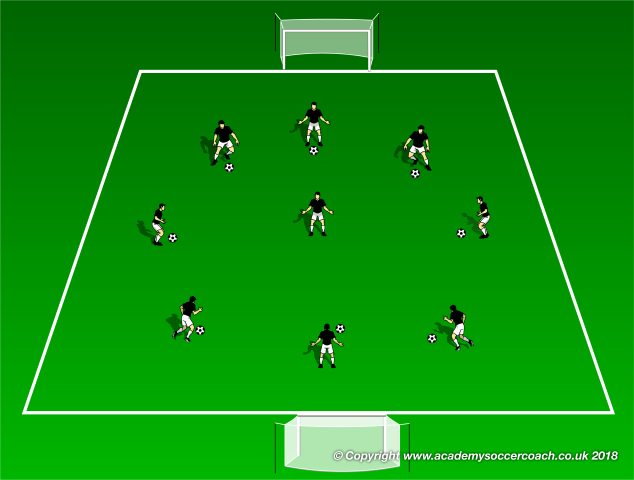
Execution: Initially, the coach yells out the name of the player passing, who then gives a difficult pass to the middle player, and a number, either one or two, which determines which goal the player in the middle should shoot on. The pass from the called player should vary from a hard pass to the feet, a lofted pass the striker needs to knock down with their head, to a driven pass at waist level.
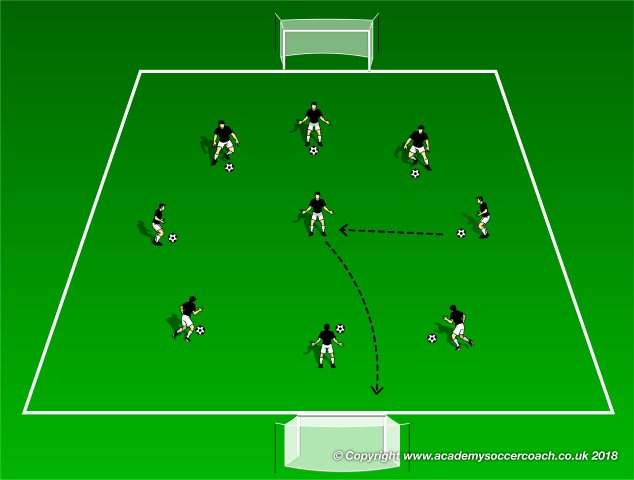
After a predetermined time the player in the middle switches with another player and the process repeats. Once every player has gone the coach can begin to call two names, the first name called passes to the player in the middle, the player in the middle passes to the second name, who then lays the ball off to the middle player for a shot on the designated goal.
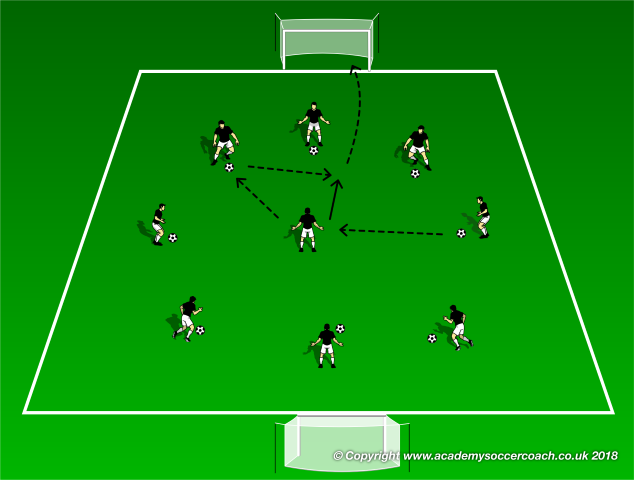
Variations:
The number of names called can vary
The player whose name is called can play a 1-2 with the middle player to set up the shot
The number and size of the goal can vary
By Matthew Carroll

Transition to Attack Drill
By Matthew Carroll
Description:
The purpose of the Transition to Attack drill is to recreate the pressure of defending in a team’s own final third and creating lighting quick counter attacks from this position using support play from the 9 and 10.
Setup:
The 10×54 yd field is split into three phases. 5 black players are placed as defenders representing the back line, the 6, and the 8. 4 yellow players are placed as attackers representing the 9s, 10, and 7/11. A red 10 is placed in the 2nd phase, and another red 9 is placed in phase 3. Balls are played in by the coach to attacking team at the edge of phase 1 and 2.
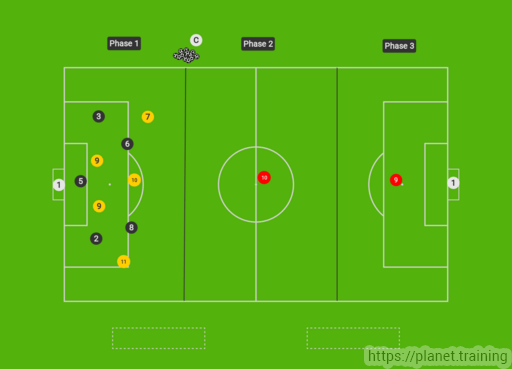
Execution:
Ball is initially played into the yellow team, who attempts to score goals against the black team. The black team then attempts to win the ball and play to the red player in phase 2.
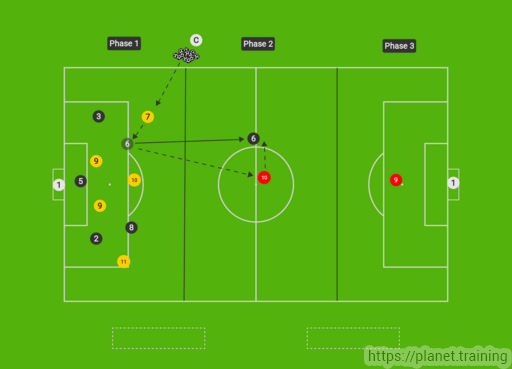
Once they have played a pass to the red player they can then move onto phase 3 where they must play a pass to the green 9. Regular out of bounds rules are applied, every restart after a goal comes from the coaches
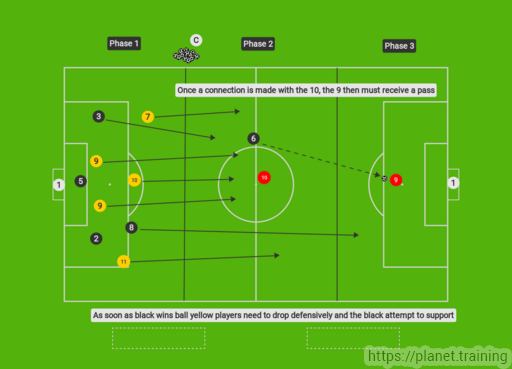
Variations:
Defenders can be added to oppose the red team
The middle line can be bypassed.
By Matthew Carroll
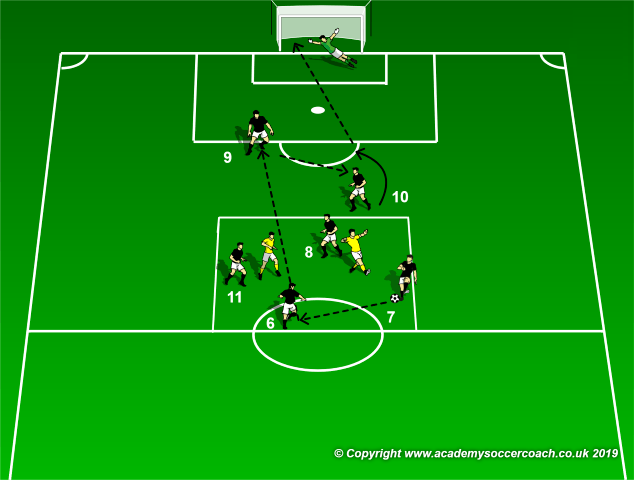
Killer Pass Game
By Matthew Carroll
Description:
The Killer Pass Game is used to enhance a player’s ability to utilize pockets of space between lines to create scoring opportunities. In addition to this the passing players must be creative and find a rapport with the receiving players. Defenders must work as a unit, and the tight space of the drill bring in a conditioning element.
Setup:
Create a grid as wide as the 18 and 5 yards out from it. Place all balls beyond the grid. Split the 18 with a single cone. Place two “Sweepers” in the two 18 grids. Place one “10” with the balls. Take every other player and split them evenly into attackers and defenders within the grid.
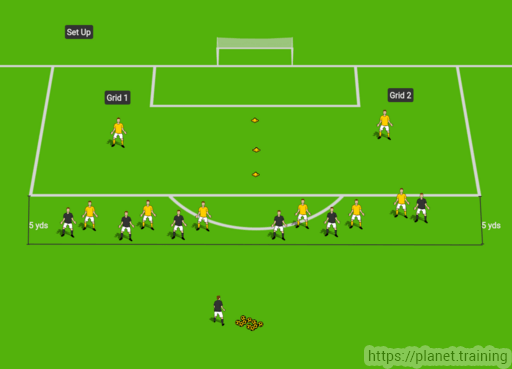
Execution:
The passer must play a ball either to one of the attackers or into the 18 for the attackers to run onto.
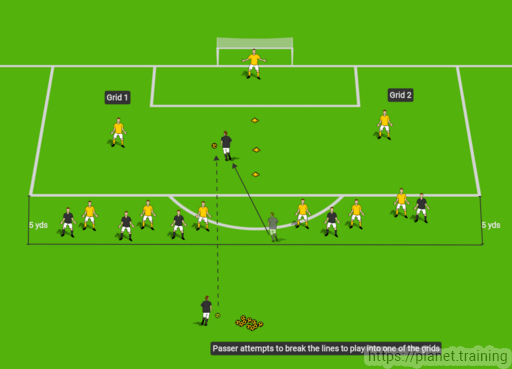
The defenders must try to stop the attacker from receiving a ball but cannot enter the 18. Once the ball is into the grid the sweepers (who must stay in their grid) must defend the attacker.
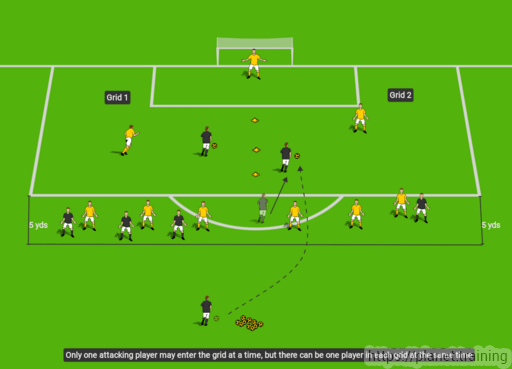
If the attacker scores he then becomes an additional passer, if he does not score he must go back into the grid outside the 18. Only one ball can be in each 18 grid at a time (so two attackers can technically be in the 18 at the same time).
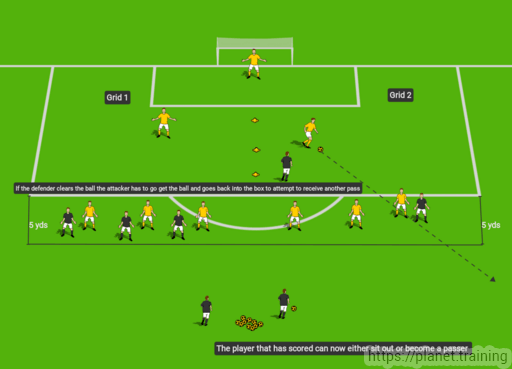
Variations:
The numbers of the attackers and defenders can vary, as well as sweepers and passers.
Players that score can be removed, or rotate in for the passer
By Matthew Carroll

Triangle Shooting Game
By Matthew Carroll
Description:
The Triangle Shooting Game is designed to create a competitive shooting environment where elements of short rhythmic passing, pass and move, as well as finishing are integrating into a short effective drill. Can be used in practice or as a pre-game warm-up
Setup:
Place three cones in a triangle about 5-10 feet apart just outside of the 18. Players line up behind furthest cone
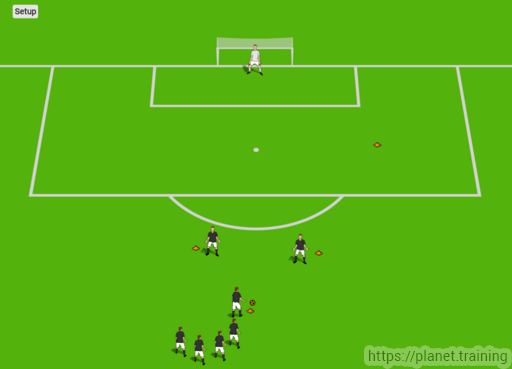
Execution:
The first player in line passes to the player at the cone to the right. That player passes the ball to the player standing at the cone diagonal himself. The ball is then laid off for the original passer who runs through the middle of the triangle and shoots the ball on net.
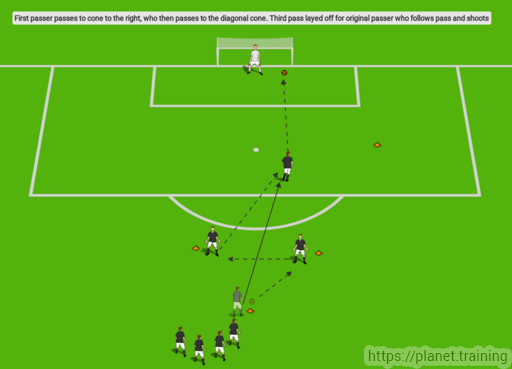
After the shot the shooter then returns to the left cone, the passer from the left cone moves to the right cone, and the passer from the right cone goes to the back of the line. The process repeats for 2 minutes.
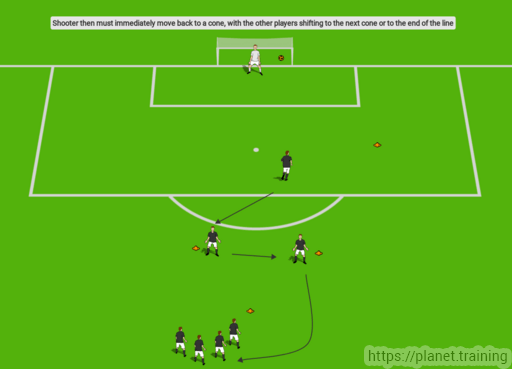
Variations:
Players can be split into two teams and the drill can become a competition
Stipulations can be added such as left foot only
By Matthew Carroll
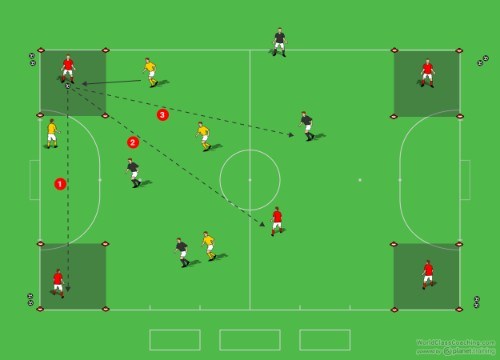
Side By Side Game
By Matthew Carroll
Description:
The purpose this game is to create full field awareness. While players must focus on the task of breaking the defensive line and scoring, they also must be aware of the game occurring simultaneously on the other side of the pitch. The game also challenges the goalkeepers to do double duty in addressing their defense, forcing them to either coordinate the defense of two attacks, or the defense of one attack and one counter attack.
Setup:
Numbers will vary based on team and space provided, but the basic game should consist of two 4v4s plus one goalkeeper. The field should be split in two through the endline, with a goal centered in between each half. The length of each of the pitches should be from endline to 15m out from the 18. Two balls are set up at opposite end of the goals.
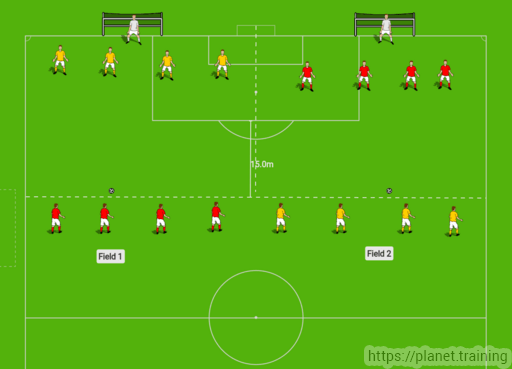
Execution:
The red team on field 1 plays a 4v4 against the yellow defenders on field 1 with the objective of scoring, the same happens on field 2 with the yellows attacking the red goal.
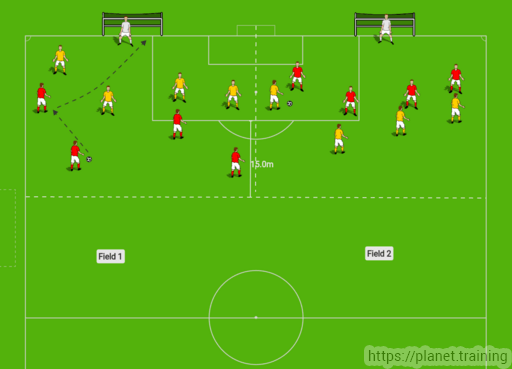
If the defenders are able to win the ball back they can then play to their attacking players on the opposite field. If a goal is scored the goalkeeper then plays to the opposite field.
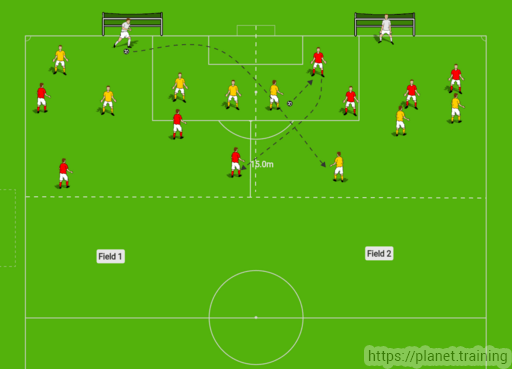
An attacking team can also gain possession of both balls on an attack, while the team on the opposite field attempts to position themselves to receive/defend on or both of the balls.
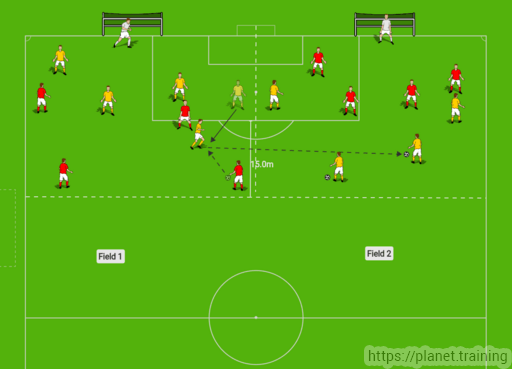
Any play that goes out of bounds is a free kick from the line, in addition, corners are allowed. The winner is the team with the most goals after the assigned time. The defending and attacking side of each team then switch and the game is restarted.
Variations:
The numbers and size of the pitch can be varied dependent on age and ability of players.
Winning stipulations can be adjusted to number of goals scored.
The fields can be adjusted to be back to back instead of side to side.
By Matthew Carroll

2v1 Striker Madness
By Matthew Carroll
Description:
The 2 v 1 Striker Madness game is meant to simulate as many situations a striker may see in the box, with pressure, as possible. The idea is that although it is a team game that implements passing, defending, and movement on and off the ball, the focus stays on the striker receiving and shooting a ball.
Setup:
Have a pile of balls (the number of balls will determine the competitiveness and the length of the game) set up about ten yards out from the 18. Have your players get into, or assign, groups of three. Within those groups have the players designated as defenders (1s) wear yellow, your passers (2s) in red, and your strikers (3s) in black. Depending on age and ability assign 1-2 goalkeepers as well. Have the defenders and strikers arrange themselves inside the 18, with the passers lining up behind the pile of balls.
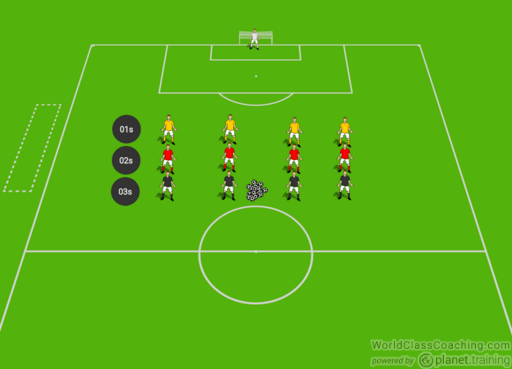
Execution:
The goal of the game is that within your team of three everyone has a role. The passer will collect balls from the pile (or from errant shots/passes/tackles) and feed passes to the striker that they are teammates with in the box. The passer only passes to the striker on his team. The passer can pass from anywhere, as long as he is outside the 18 (this includes from behind the net). It is the strikers job then to receive passes from his teammate, the passer, and score goals. Every goal scored by the striker is a point for his team. The defenders job is then to ensure that none of the other strikers are able to score, and defend as many balls played in as possible.
2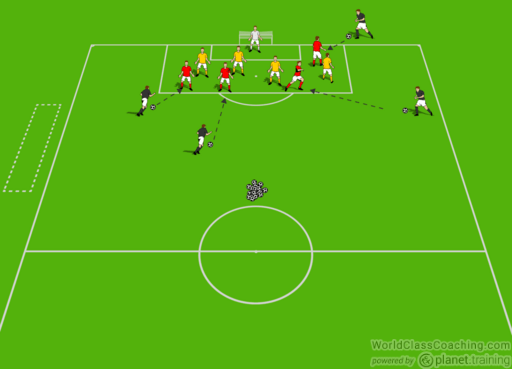
The game ends when either all of the balls have been scored, or a certain time limit has been reached. Once the game ends the 1 becomes the 2, the 2 the 3, and the 3 the 1, and the game begins again.
Variations:
Additional strikers/passers/defenders can be added to each team.
The number of balls and winning conditions can be changed to all balls are scored, a certain number of goals, or a time limit.
Goalkeeper numbers can vary, or be replaced by targets.
Touch restrictions can be made to the strikers.
Defenders can be assigned specific strikers to mark.
An additional twist can be that defenders can pass to their strikers in the box, working on the transitional phase.
By Matthew Carroll
